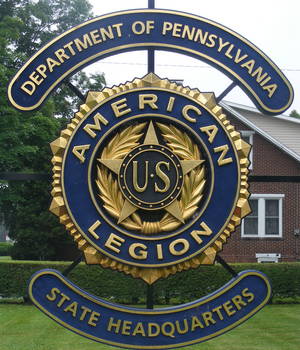Legion PA State Headquarters

The Department of Pennsylvania was founded on June 12, 1919, when the temporary National Headquarters in New York granted it a charter. The Department’s immediate origins go back to the historic meetings in Paris, where the launch of the National organization began.
In 1919 National Commander D’Olier congratulated the Department Officers by noting “that in no other state in the union has there been put over a more substantial job than in the state of Pennsylvania.”
From the start, The American Legion became the most visible proponent of the rights and entitlements of veterans. The problems of veterans returning from war were widely recognized then as they are today.
The year 1921 was marked by a surge of activity by the Legion on behalf of sick and disabled veterans. More than 11,300 cases were taken up by the Veterans Bureau through the regional agencies. The Pennsylvania American Legion State Committee on Medical Aid and Disabled Veterans demanded that the Veterans Bureau treat claimants “as men, not mendicants,” and that adequate hospitals be built quickly.
In the mid 20′s local Legion Posts saw the importance of the media and public relations. In small towns and cities alike Pennsylvania American Legion Posts put on their own radio shows. Scranton presented a program on “The Bonus”. Altoona broadcast all-Legion talent nights to stimulate membership drives throughout the area.
During this time, the struggle for veterans’ benefits in Pennsylvania mirrored the fight to protect veterans under a national policy. The Pennsylvania Legion charged itself with putting the plight of the suffering and disabled on the front burner as they continued to press this concern. In 1924, only after considerable pressure from veterans’ groups, was enough money allocated to build veterans’ hospitals across the country.
By 1930, the Pennsylvania Legion concluded a successful year when membership exceeded 73,000 in 567 Posts. The Pennsylvania American Legion worked to improve the status of World War veterans, mainly men reaching middle age in a difficult employment market. In 1938 the Employment Committee led the fight to maintain opportunities for men over forty. This campaign used the virtues of the experienced man, civilian or veteran, and urged businessmen to pledge and hire a percentage of men over forty; they obtained pledges from U.S. Steel, the Pennsylvania Railroad, Mellon Bank, coal companies, and others.
The period between 1940 and 1954 saw great change in the Pennsylvania American Legion. World War II provided a new generation of servicemen eligible for membership. And the Cold War fears created new Legion activities and enhanced the value of existing ones.
In 1940 we were the third largest Department in the Legion with more than 100,000 members. Pennsylvania’s sons of the Legion led the nation in membership with 6,500. And by 1944 the Auxiliary brought its membership to the goal of 53,800.
In the 40′s one of the biggest reasons to join the Legion was its unyielding support for the GI Bill. The GI Bill provided home and farm mortgage loans, free medical care, unemployment insurance, disability allowances, and vocational and college educations.
By 1950, the growth of the Pennsylvania American Legion was evident everywhere. Veterans of Leyte Gulf, Iwo Jima, and Normandy beaches rubbed shoulders with survivors of the Chateau-Thierry and Argonne offensives. In 1953, the average age of a Pennsylvania State veteran was about thirty-eight. As men with new families, the Legion programs emphasized service to the family, community, and nation. Legion baseball and other youth activities flourished as the “baby boom” flourished.
The years between Korea and Vietnam saw both continuity and change in the Pennsylvania Legion. Commanders came and went, conventions were held every summer, and posts went about their business. At the same time, there were massive changes in culture and society. The Vietnam War forced the Legion to take controversial but consistent stands in defense of the nation.
By 1968 final papers were signed for the purchase of land in Wormleysburg, where a new headquarters was to be constructed. The work began on the fiftieth anniversary of the National Organization. This coincided with publicity drives such as Operation Servicemen and Freedom Is Not Free, which provided much-needed reminders of the sacrifices of veterans.
The Pennsylvania American Legion supported federal legislation to research Agent Orange-related illness and treat the effects. At that time, we also provided an Agent Orange hot line manned by Legionnaires, health care professionals, and Vietnam veterans.
In 1985 Congress’s decision to cut spending on veterans; medical care was to be restricted to those with strictly service-connected disabilities, former prisoners of war, pensioners, and sick veterans “with demonstrated needs.” The Pennsylvania American Legion strictly opposed restricting veterans’ benefits according to need. This stand awakened many Legionnaires as to how times had changed. More than 1000 veterans demonstrated at ten VA medical centers in Pennsylvania on Saturday, May 26, 1990.
In 1987, Department Officers organized an innovative program for aiding homeless and drug-dependent veterans. Housing for Homeless Veterans was born when HFHV purchased an abandoned four-unit home in Pittsburgh to help homeless veterans with transitional housing. Today HFHV has expanded to homes in Philadelphia and Ephrata.
For more than nine decades The Pennsylvania American Legion existed to represent the people in uniform and we will continue to do so with dignity and honor.
